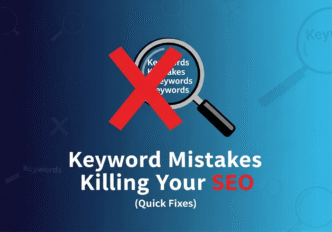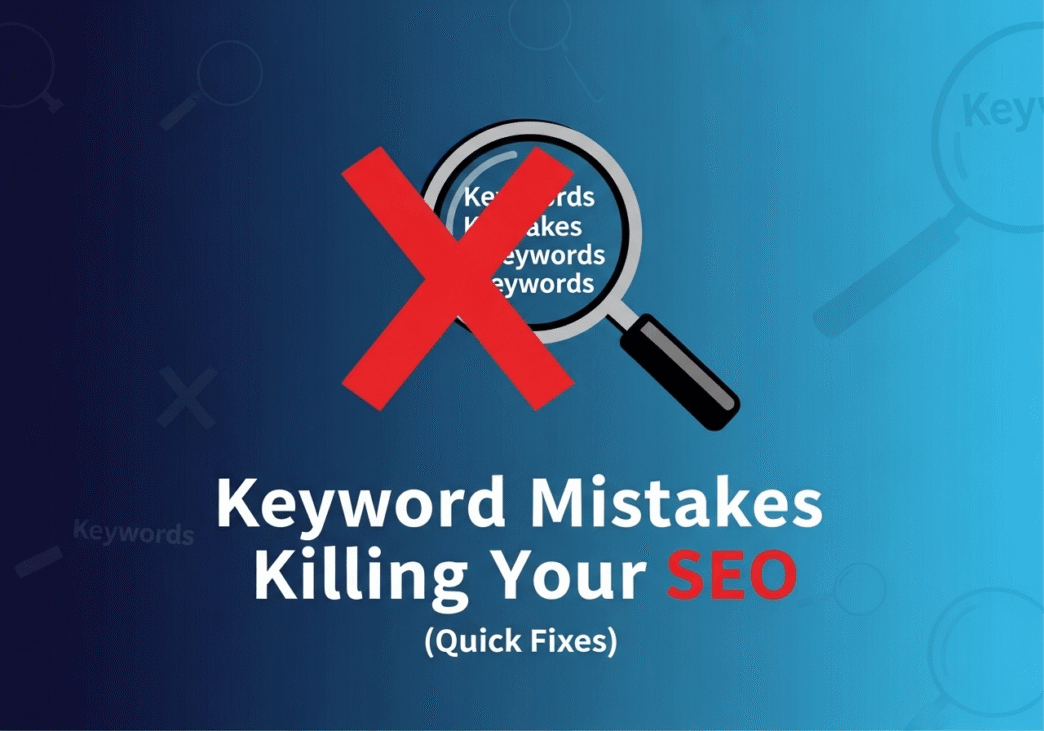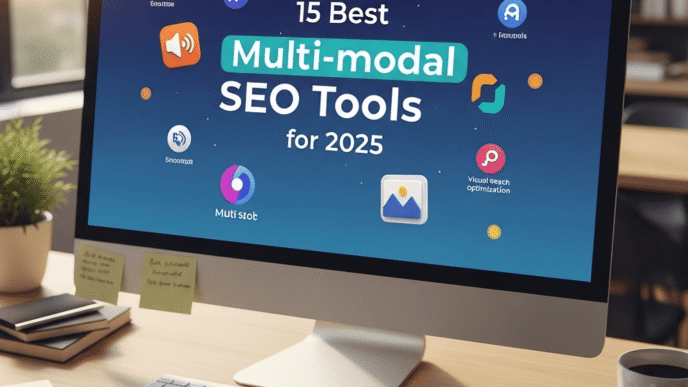Ever wonder why your competitor’s blog ranks on Google’s first page while yours is buried deeper than a treasure chest in the Bermuda Triangle? Here’s the harsh truth: you might be committing keyword research mistakes that are silently assassinating your SEO efforts. While you’re busy creating amazing content, these sneaky errors are telling Google to ignore your website completely.
Don’t worry – you’re not alone! Even seasoned marketers fall into these keyword traps. The good news? These SEO keyword errors are surprisingly easy to fix once you know what to look for. Ready to resurrect your rankings from SEO purgatory?
Table of Contents
ToggleWhat Are the Most Common Keyword Research Mistakes Beginners Make?
Before we dive into the specific mistakes, let’s understand why keyword research problems are so devastating. According to Ahrefs’ analysis of 2 million searches, 90.63% of pages get zero organic traffic from Google, and poor keyword strategy is the #1 culprit.
Keyword research mistakes aren’t just about picking the wrong words – they’re about misunderstanding search intent, ignoring competition, and making assumptions about what your audience actually wants.
Pro Tip: The difference between successful and struggling websites often comes down to keyword strategy execution, not content quality. Great content with poor keyword targeting equals invisibility!
“Most businesses fail at SEO not because they can’t create good content, but because they optimize for keywords nobody searches for or they can’t realistically rank for.” – SEO Strategy Expert
Mistake #1: Chasing High-Volume Keywords You Can’t Rank For (The David vs Goliath Error)
The Problem:
New websites targeting keywords like “digital marketing” (450,000 monthly searches) while competing against HubSpot, Neil Patel, and Moz. It’s like bringing a water pistol to a tank battle.
Why This Keyword Strategy Mistake Hurts:
- Established domains with 90+ domain authority dominate high-volume terms
- Your new site has virtually zero chance of ranking
- You waste months creating content that never gets seen
- Resources get drained chasing impossible targets
Real-World Example:
A new fitness blog tried ranking for “weight loss” (450K searches/month) for 8 months with zero results. They switched to “weight loss for busy moms over 40” (800 searches/month) and ranked #3 within 6 weeks.
The Quick Fix:
| Keyword Difficulty Level | Monthly Searches | Realistic for New Sites? | Action Plan |
|---|---|---|---|
| 0-20 (Easy) | 100-2,000 | ✅ Target immediately | Start here |
| 21-40 (Medium) | 500-5,000 | ✅ Target after 6 months | Plan for later |
| 41-60 (Hard) | 1,000-20,000 | ⚠️ Target after 1+ years | Long-term goal |
| 61+ (Impossible) | 10,000+ | ❌ Avoid until domain authority 50+ | Focus elsewhere |
Pro Tip: Use tools like Ubersuggest or SEMrush to check keyword difficulty scores. Start with difficulty under 30 for new websites!
For comprehensive guidance on selecting winnable keywords, check our complete keyword research strategy guide.
Mistake #2: Ignoring Search Intent (The Content Mismatch Disaster)
What Is This Keyword Optimization Error?
Creating informational content when searchers want to buy, or writing product pages when people need tutorials. It’s like offering someone a hamburger when they asked for directions.
The Four Types of Search Intent:
1. Informational Intent – “How to” questions 2. Navigational Intent – Specific website searches
3. Commercial Intent – “Best” or “review” searches 4. Transactional Intent – “Buy” or “purchase” searches
Classic Intent Mismatch Examples:
Wrong: Writing “How to choose running shoes” for keyword “buy Nike running shoes”
Right: Creating a product page with reviews and purchase options
Wrong: Building a sales page for “how to start a blog”
Right: Creating a step-by-step tutorial guide
Intent Analysis Quick Check:
- Google your target keyword
- Look at top 10 results
- Note the content format (blog, product page, review, guide)
- Match your content to the dominant format
Pro Tip: According to Search Engine Land research, pages that match search intent rank 40% higher than those that don’t, regardless of other SEO factors.
Mistake #3: Keyword Stuffing (The Spam Sandwich Problem)
The Outdated SEO Keyword Fails Approach:
Cramming your focus keyword into every sentence like you’re being paid per mention. Modern Google AI can spot this amateur move from orbit.
What Keyword Stuffing Looks Like:
Bad Example: “Best pizza delivery Chicago offers the best pizza in Chicago. Our Chicago pizza delivery service delivers the best Chicago pizza to Chicago residents who want Chicago-style pizza delivered.”
Good Example: “Our Chicago pizza delivery brings authentic deep-dish and tavern-style pies directly to your door. We serve 15 neighborhoods across the city with fresh, hot pizza in 30 minutes or less.”
The Modern Keyword Approach:
- Use your main keyword 1-2 times naturally
- Include 2-3 semantic variations
- Focus on topic coverage, not keyword density
- Write for humans first, search engines second
Keyword Density Guidelines:
| Content Length | Main Keyword Usage | Semantic Variations |
|---|---|---|
| 500 words | 1-2 times | 2-3 related terms |
| 1,000 words | 2-3 times | 4-5 related terms |
| 2,000+ words | 3-5 times | 6-8 related terms |
Pro Tip: Google’s RankBrain understands synonyms and context. Instead of repeating “car insurance,” use variations like “auto coverage,” “vehicle protection,” and “car insurance policies” naturally throughout your content.
Mistake #4: Targeting Multiple Keywords Per Page (The Focus Fragmentation Fiasco)
The Confusion Common SEO Mistakes Create:
Trying to rank one page for “email marketing,” “social media marketing,” and “content marketing” simultaneously. Google gets confused about your page’s primary purpose and ranks you poorly for everything.
Why This Keyword Targeting Mistake Backfires:
- Dilutes topical authority
- Confuses search engine understanding
- Reduces content depth for each topic
- Leads to thin, unfocused content
The One-Page, One-Primary-Keyword Rule:
Successful Approach:
- Primary keyword: “email marketing for small business”
- Supporting keywords: “small business email campaigns,” “email marketing tips,” “business email newsletters”
- Content focus: Everything relates to email marketing for small businesses
Topic Cluster Strategy:
Instead of cramming multiple topics into one page, create:
- Pillar page: “Complete Guide to Email Marketing for Small Business”
- Cluster pages:
- “Email Marketing Automation for Small Business”
- “Email Marketing Templates for Small Business”
- “Email Marketing Analytics for Small Business”
Pro Tip: Each page should target one primary keyword with 2-3 closely related supporting terms. Save other topics for separate, dedicated pages that link back to your main pillar content.
For detailed cluster content strategies, explore our keyword research and content planning guide.
Mistake #5: Not Researching Competitor Keywords (The Blind Strategy Blunder)
The Missed Opportunity Keyword Selection Errors:
Guessing which keywords to target instead of analyzing what already works in your industry. It’s like trying to find buried treasure without a map when your competitors have GPS coordinates.
What You’re Missing Without Competitor Analysis:
- Proven keyword opportunities in your niche
- Content gaps you can exploit
- Realistic difficulty assessments
- Seasonal keyword patterns
- Long-tail variations that convert
Simple Competitor Research Process:
Step 1: Identify your top 5 competitors Step 2: Use free tools to analyze their top keywords Step 3: Find keywords they rank for that you don’t Step 4: Assess which ones you can realistically target Step 5: Create better content for those keywords
Free Competitor Analysis Tools:
| Tool | Best For | Cost | Keyword Limit |
|---|---|---|---|
| Ubersuggest | Basic competitor overview | Free | 3 searches/day |
| SEMrush | Comprehensive analysis | Free trial | 10 searches/day |
| SimilarWeb | Traffic and popular pages | Free | Unlimited |
| Manual Google Search | Content format analysis | Free | Unlimited |
Case Study: The HVAC Company That Stole Success
Problem: Local HVAC company couldn’t rank for “air conditioning repair
Solution: Analyzed competitors and found they were all ignoring “emergency AC repair near me” and “24-hour air conditioning service [city name]”
Result: Ranked #1 for emergency keywords within 3 months, increased emergency service calls by 190%
Pro Tip: Don’t just copy competitor keywords – find the gaps they’re missing and dominate those opportunities first!
Mistake #6: Forgetting About Long-Tail Keywords (The Specificity Oversight)
The Broad Keyword Trap:
Targeting “shoes” instead of “comfortable running shoes for flat feet women.” Broad keywords have massive competition and vague intent, while long-tail keywords have laser-focused intent and lower competition.
Why Keyword Research Problems Include Long-Tail Neglect:
According to WordStream’s analysis, long-tail keywords account for 70% of all search traffic and have 2.5x higher conversion rates than broad terms.
Long-Tail Keyword Benefits:
- Lower competition (easier to rank)
- Higher conversion rates (specific intent)
- More qualified traffic (knows exactly what they want)
- Voice search optimization (how people actually speak)
Long-Tail Keyword Examples by Industry:
| Industry | Broad Keyword | Long-Tail Alternative | Monthly Searches | Competition |
|---|---|---|---|---|
| Fitness | “workout” | “15-minute morning workout for busy moms” | 1,200 | Low |
| Food | “recipes” | “healthy meal prep recipes for weight loss” | 2,400 | Medium |
| Tech | “software” | “project management software for remote teams” | 880 | Low |
| Travel | “hotels” | “pet-friendly hotels near Yellowstone National Park” | 590 | Low |
Long-Tail Discovery Methods:
- Google Autocomplete – Start typing and see suggestions
- People Also Ask – Expand questions for more ideas
- Related Searches – Bottom of Google results page
- Customer Support – Questions people actually ask
- Forum Mining – Reddit, Quora, industry forums
For advanced long-tail keyword strategies, check our long-tail keyword research masterclass.
Mistake #7: Not Tracking and Adjusting Keywords (The Set-and-Forget Failure)
The Static Strategy Keyword Research Errors:
Publishing content with target keywords and never monitoring performance. SEO isn’t a “set it and forget it” crockpot – it’s a garden that needs constant tending.
What Happens Without Keyword Monitoring:
- Miss opportunities to improve rankings
- Don’t notice when keywords start declining
- Can’t identify new keyword opportunities
- Waste time on keywords that don’t convert
Essential Keyword Tracking Metrics:
🎯 Ranking Position – Where you appear in search results 🎯 Click-Through Rate – Percentage of people who click your result 🎯 Organic Traffic – Visitors from keyword searches 🎯 Conversion Rate – How many searchers take desired actions 🎯 Search Volume Changes – Seasonal or trending fluctuations
Free Keyword Tracking Tools:
- Google Search Console – Your website’s search performance
- Google Analytics – Traffic and conversion data
- Google Trends – Search volume changes over time
- Ubersuggest – Basic rank tracking (limited)
Monthly Keyword Review Process:
Week 1: Export keyword performance data Week 2: Identify top and bottom performers Week 3: Optimize underperforming content Week 4: Plan new content for opportunity keywords
Pro Tip: Set up Google Search Console alerts for ranking changes. When a page drops significantly, investigate immediately – early intervention often prevents major ranking losses!
How to Avoid Keyword Research Mistakes (Your Prevention Checklist)
Pre-Publication Keyword Checklist:
✅ Keyword difficulty under 30 for new websites ✅ Search intent matches content format ✅ One primary keyword per page ✅ Natural keyword integration (no stuffing) ✅ Competitor analysis completed ✅ Long-tail variations included ✅ Tracking setup implemented
Monthly Keyword Audit Questions:
- Which keywords are gaining/losing rankings?
- What new opportunities have competitors found?
- Are seasonal trends affecting performance?
- Which content needs keyword optimization updates?
- What new long-tail variations are emerging?
“The biggest SEO mistake isn’t picking bad keywords – it’s not monitoring and improving your keyword strategy over time. SEO is a marathon, not a sprint.” – Technical SEO Expert
For comprehensive keyword tracking and optimization strategies, visit our advanced keyword management guide.
Real-World Recovery: From Keyword Disaster to SEO Success
Case Study: The E-commerce Store That Fixed Everything
The Disaster: Online outdoor gear store making all 7 keyword mistakes simultaneously:
- Targeting “camping gear” (impossible competition)
- Mixing search intents on product pages
- Keyword stuffing product descriptions
- Multiple focus keywords per page
- Zero competitor research
- Ignoring long-tail opportunities
- No performance tracking
The 90-Day Recovery Plan:
Month 1: Keyword difficulty audit and intent realignment Month 2: Content optimization and long-tail targeting Month 3: Competitor gap analysis and new content creation
The Results:
- Organic traffic: 12,000 → 47,000 monthly visitors (+292%)
- Keyword rankings: 15 first-page keywords → 89 first-page keywords
- Conversion rate: 1.2% → 3.8% (better-targeted traffic)
- Revenue impact: $28,000 → $94,000 monthly (+236%)
Key Success Factors:
- Realistic targeting – Focused on keywords they could actually rank for
- Intent optimization – Matched content format to search intent
- Natural optimization – Eliminated keyword stuffing completely
- Topic clustering – One focus keyword per page with supporting terms
- Competitive intelligence – Found gaps competitors were missing
- Long-tail dominance – Captured specific, high-intent searches
- Continuous monitoring – Monthly optimization based on performance data
Your Keyword Mistake Recovery Action Plan
Week 1: Audit and Assessment
- Run keyword difficulty check on current targets
- Analyze search intent match for top pages
- Identify keyword stuffing instances
- List pages with multiple focus keywords
Week 2: Competition and Opportunity Analysis
- Research top 5 competitor keyword strategies
- Find keyword gaps you can exploit
- Build list of realistic long-tail opportunities
- Set up tracking for current and new keywords
Week 3: Content Optimization
- Fix keyword stuffing with natural language
- Align content format with search intent
- Optimize pages for single focus keywords
- Add long-tail variations naturally
Week 4: Implementation and Monitoring
- Publish optimized content
- Set up performance tracking
- Create monthly review schedule
- Plan next month’s keyword targets
Pro Tip: Don’t try to fix everything at once. Pick your biggest mistake, fix it completely, then move to the next. Gradual, consistent improvement beats overwhelming yourself with changes!
For step-by-step implementation support, reference our keyword research implementation roadmap.
Final Thoughts: Your Keyword Redemption Story Starts Now
Keyword research mistakes aren’t permanent death sentences for your SEO – they’re learning opportunities disguised as setbacks. Every successful website has made these errors at some point. The difference between winners and losers is recognition, acceptance, and action.
The beautiful thing about fixing SEO keyword errors is that results often come quickly. Unlike building domain authority or earning backlinks, keyword optimization improvements can show ranking gains within weeks of implementation.
Remember: Google rewards websites that solve real problems for real people using the language those people actually search with. When you stop making these common SEO mistakes and start speaking your audience’s search language, magic happens.
Your content doesn’t need to be perfect – it just needs to be better than what currently ranks. Fix these seven keyword mistakes, and you’ll often find that “better” is easier to achieve than you imagined.
Start with one mistake, fix it completely, then tackle the next. Your future self (and your Google Analytics) will thank you for taking action today instead of waiting for the “perfect” moment that never comes.
Ready to transform your keyword strategy from liability to asset? Your SEO redemption story begins with the first fix you implement today.
Frequently Asked Questions
Q: How quickly can I expect to see results after fixing keyword research mistakes? A: Simple fixes like keyword stuffing removal and intent alignment can show improvements in 2-4 weeks. More complex changes like targeting new keywords typically take 6-12 weeks to show significant results.
Q: Should I completely abandon high-competition keywords? A: Not necessarily, but prioritize them appropriately. Build authority with low-competition keywords first, then gradually target more competitive terms as your domain authority grows over 6-12 months.
Q: How do I know if my keyword density is too high? A: If reading your content feels unnatural or repetitive, you’re probably keyword stuffing. Focus on natural language that serves readers first. Modern SEO tools like Yoast or Surfer can help identify over-optimization.
Q: Can I target multiple related keywords on the same page? A: Yes, but stick to one primary keyword with 2-3 closely related supporting terms. For example, target “email marketing for small business” with supporting terms like “small business email campaigns” and “business email newsletters.”
Q: What’s the best free tool for checking keyword difficulty? A: Ubersuggest offers reliable free keyword difficulty scores, though limited to 3 searches per day. Google Keyword Planner provides competition data but requires a Google Ads account setup.
Q: How often should I update my keyword strategy? A: Review keyword performance monthly, with major strategy updates quarterly. Set up Google Search Console alerts for significant ranking changes that require immediate attention.













